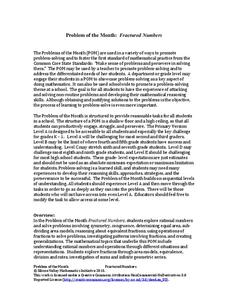Curated OER
New York State Testing Program: Mathematics Grade 5
For this New York state grade 5 math test, 5th graders complete a set of 26 problems covering a wide variety of 5th grade math concepts.
Curated OER
New York State Testing Program Mathematics Book 1 Grade 7
In this grade 7 math knowledge test, 7th graders complete 30 multiple choice problems from a wide variety of math skills.
Curated OER
Solving Equations with Addition and Subtraction
Students solve equations using addition and subtraction. In this algebra lesson, students write word problems as equations and simplify the equations. They solve for the unknown using addition and subtraction.
Curated OER
New York State Testing Program Mathematics Grade 7
In this seventh grade worksheet, 7th graders assess their knowledge and understanding of grade level mathematics. The twenty-two page worksheet contains thirty multiple choice questions. Answers are not provided.
Curated OER
Pictogram 1 and 2
In this mathematical worksheet, students experience problem solving two pictograms dealing with favorite animals and rainy days.
Curated OER
Amanda's Valentine's Day Party
In this Amanda's Valentine's Day party activity, students problem solve five mathematical word problems involving fractions, addition and subtraction.
Alabama Learning Exchange
Mix it Up! Exploring the Commutative and Associative Properties of Addition
Examine commutative and associative properties with your class. They'll explore the relationships between addition and subtraction and investigate patterns as they solve addition problems. Links to an assessment and a table game are...
Curated OER
Domain: Operations and Algebraic Thinking
Practice basic operations for young mathematicians in fun ways! Using two decks of cards (Ace through 10 plus the joker), learners play "memory" by matching numbers that can be added to make 10 and writing number sentences. In another...
Curated OER
Properties of Equality
What assumptions are made in order to solve equations? An instructional slideshow provides an overview and guided examples of how properties of equality can be used to justify each step in solving equations.
Curated OER
Properties of Operations as Strategies
These multiplication problems give scholars a chance to display their knowledge of math properties. They use the zero property to solve one problem, write a related multiplication fact for a division problem, and complete a final...
Curated OER
Multiplying by Using the Commutative Property
In these multiplication worksheets, students examine the use of the commutative and associative properties. They use the communative property to find the product in the first 30 problems. They read about the use of the associative...
Curated OER
The Learning Book
First graders identify, comprehend, and evaluate the content and artistic aspects of oral and visual presentations. Then they participate in formal and informal presentations and discussions of issues and ideas. Students also create...
Curated OER
Associative Property of Multiplication
Third graders discover the associative property of multiplication. For this multiplication lesson, 3rd graders explore visual examples of using the commutative and associative properties of multiplication. They also practice solving...
Curated OER
Arithmetic Associative Property of Addition 2
Practice and solve 16 problems in which the missing number in an addition equations is calculated and filled in. Each addition problem shows the associative property. Multiple links to additional worksheets are located on this page.
Curated OER
Arithmetic Associative Property of Addition 3 Worksheet
Provide the opportunity to practice solving problems using the associative property of addition. The class completes a set of 16 simple, single digit problems using the associative property. This Page has multiple links to additional...
Curated OER
World Hunger - A Cultural Crisis
Students explore the problem of world hunger and starvation. After a class discussion, students use a map to identify specific areas where populations are starving. In groups, students research reasons for the lack of food. They prepare...
CPM
Unit 3, Worksheet 1, Exponents and Algebraic Expressions
Need exponentt practice? Then this exponent worksheet will be helpful to have learners evaluate exponent expressions and algebraic expressions. They use the distributive property to solve equations. This three-page worksheet contains...
World Wildlife Fund
Take 6
Investigate the various properties of the number six with this elementary math lesson. From simple addition, subtraction, multiplication, and division problems to the creation of hexagonal tessellations, this lesson covers all aspects of...
Noyce Foundation
Time to Get Clean
It's assessment time! Determine your young mathematicians' understanding of elapsed time with this brief, five-question quiz.
California Education Partners
Cady's Cats
How much can a cat eat? The five-question fraction assessment asks pupils to determine the fractional portion of a food box eaten by cats. Learners show their proficiency in adding and subtracting fractions using several scenarios...
Curated OER
Candy Machine
Using the concept of a candy vending machine, young mathematicians explore the sugar ratios found in different types of candy. Using the provided information, class members calculate and compare different ratios in...
Noyce Foundation
Piece it Together
Score some problems all related to soccer balls. The first few problems focus on pattern blocks to see relationships between figures. More advanced problems focus on actual soccer balls, the patterns on the balls, and their volumes and...
Noyce Foundation
Fractured Numbers
Don't use use a fraction of the resource — use it all! Scholars attempt a set of five problem-of-the-month challenges on fractions. Levels A and B focus on creating fractions and equivalent fractions, while Levels C, D, and E touch on...
Noyce Foundation
Part and Whole
Now you'll never have trouble cutting a cake evenly again. Here is a set of five problems all about partitioning shapes into a given number of pieces and identifying the fractional amount of each piece. As learners progress through the...

























